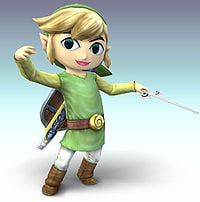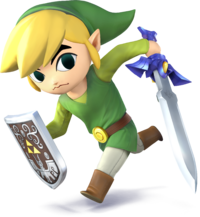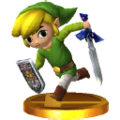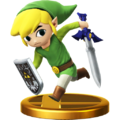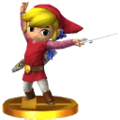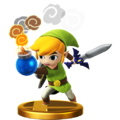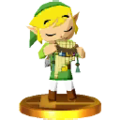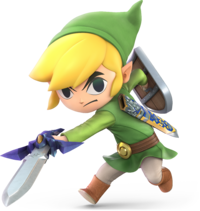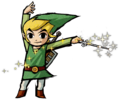Toon Link
- For fighter info, see Toon Link (SSBB), Toon Link (SSB4), and Toon Link (SSBU).
- "Toon" redirects here. For the Chilean smasher, see Smasher:Toon.
| Toon Link | |
|---|---|
File:HWL Toon Link Artwork.png Official artwork of Toon Link from Hyrule Warriors Legends. | |
| Universe | The Legend of Zelda |
| Debut | The Legend of Zelda: Four Swords (2002, general concept) The Legend of Zelda: The Wind Waker (2002, representation in the Super Smash Bros. series) |
| Smash Bros. appearances | Brawl SSB4 Ultimate |
| Most recent non-Smash appearance | WarioWare Gold (2018, cameo) |
| Console/platform of origin | Game Boy Advance (art style) Nintendo GameCube (Hero of Winds) |
| Species | Hylian |
| Gender | Male |
| Place of origin | Outset Island, Great Sea (Hero of Winds) Aboda Village, New Hyrule (Engineer Link) Hyrule (other incarnations) |
| Created by | Yoshiki Haruhana[1] Eiji Aonuma |
| Designed by | Yoshiki Haruhana[1] |
| Voice actor | Sachi Matsumoto |
| Article on Zelda Wiki | Toon Link |
Toon Link (トゥーンリンク, Toon Link) is one of Link's multiple incarnations in The Legend of Zelda series. Although several Links appear with the cel-shaded art style that Toon Link's design is based on, the one that appears as a playable character in the Super Smash Bros. series is the Hero of Winds, the main protagonist of The Legend of Zelda: The Wind Waker and The Legend of Zelda: Phantom Hourglass.
Toon Link made his Super Smash Bros. series debut in Super Smash Bros. Brawl as a playable character, and has appeared in every proceeding game since then.
Origin
Toon Link is one of the various incarnations of Link from The Legend of Zelda series. While the art style associated with the "Toon" term was technically established during the development cycle of The Legend of Zelda: The Wind Waker and was depicted in 2D artwork alongside The Legend of Zelda: Four Swords, the first usage of the term itself occurred in Super Smash Bros. Brawl to denote the Hero of Winds from The Wind Waker and The Legend of Zelda: Phantom Hourglass.
Although the Hero of Winds is the most prevalent of the Toon-styled Links, the term itself can also be used to describe the same art style, as Hyrule Warriors demonstrated in regard to the Princess Zelda from The Legend of Zelda: Spirit Tracks.[2]
Despite being the Hero of the Winds, Toon Link's appearances in the Super Smash Bros. series nevertheless make references to other Toon-styled Links: three of his alternate costumes are based on the red, blue and purple Links from The Legend of Zelda: Four Swords and The Legend of Zelda: Four Swords Adventures, his trophies in SSB4 list Spirit Tracks and "a few other titles" alongside The Wind Waker as appearances, and his Classic Mode route in Ultimate is based on The Legend of Zelda: Tri Force Heroes.
Due to his cartoonish design, Toon Link has been shown to emote exaggeratedly; this is especially evident in The Legend of Zelda: The Wind Waker HD via the Picto Box's selfie feature, and has been displayed in varying degrees by other Toon-styled Links.
Although Toon Link shows the determination and courageousness that his fellow incarnations are renowned for, his personality is also one of the most diverse of any incarnation: he is consistently shown to be carefree, easily excitable, and jovial to the point of smiling often, as well as appearing awestruck or wary upon arriving at new locations or encountering new foes. Toon Link has also shown a level of astuteness atypical for someone his age, as he will freely observe certain objects of interest in his immediate surroundings, such as an enemy's discarded weapon.
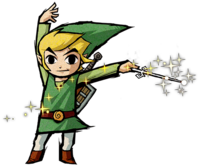
The Hero of Winds
In The Legend of Zelda: The Wind Waker, set hundreds of years after The Legend of Zelda: Ocarina of Time and within the Adult Link Timeline, the Golden Goddesses flooded Hyrule in order to stop Ganondorf following his escape from the Sacred Realm. This, in turn, created the Great Sea, which encompasses the highest mountaintops of Hyrule.
At the beginning of the game, Link's younger sister Aryll is captured by the Helmaroc King, a giant masked bird that mistook her for the pirate captain Tetra. After some persuasion, Tetra agrees to help Link chase after the Helmaroc King in order to rescue Aryll. During this pursuit, Link discovers that the bird is under the control of Ganondorf, who is revealed to be searching for Princess Zelda.
However, before he can clash with Ganondorf, Link is launched into the Great Sea by the Helmaroc King. After being saved by the King of Red Lions, Link then undergoes many trials, which includes acquiring the Wind Waker and rescuing Aryll, which results in The King of Red Lions bestowing him the title "Hero of Winds".
With Aryll safely on board Tetra's Ship alongside the pirate crew, Link discovers that his quest is not yet complete, as Ganondorf still poses a threat to the world now that the seal holding his power has been fully broken. Tetra and The King of Red Lions are eventually revealed to be Princess Zelda and King Daphnes Nohansen Hyrule, respectively, the last members of the Royal Family of Hyrule. As a result, Link takes Zelda to the underwater Hyrule Castle to keep her and the Triforce of Wisdom safe, after which he proceeds to restore the Master Sword's power to repel evil and reassemble the Triforce of Courage.
Now properly equipped, Link, with additional assistance from Zelda, manages to seal Ganondorf by plunging the Master Sword into his head just before Hyrule is fully submerged within the Great Sea, as per Daphnes' Triforce-granted wish of Link and Zelda having a future. With the world saved and Aryll safely returned to their grandmother on Outset Island, Link decides to accompany Tetra and her crew to set sail for for new lands, with Aryll, their grandmother and the rest of Outset Island's population tearfully saying goodbye while Link reciprocates the heartfelt feeling.
Some time after The Wind Waker, the events of The Legend of Zelda: Phantom Hourglass unfold. As the crew searches for new lands, Link, Tetra and the crew encounter the Ghost Ship during their search, which, when boarded, suddenly turns Tetra to stone and teleports Link to the World of the Ocean King, where Tetra is imprisoned by Bellum. Link finds the Phantom Hourglass, an item that protects him from the life-draining magic emitting from the Temple of the Ocean King, but only as long as it has sand in it. In addition to the Hourglass, he is accompanied by Ciela, a new fairy companion, and Linebeck, a cowardly and greedy captain. Together, they journey to various islands that bring Link one step closer to defeating Bellum.
Eventually, Link forges the Phantom Sword and defeats Bellum, saving Tetra. Oshus, the Ocean King, is restored to his original form, and he transports Link and Tetra back to their own realm. Tetra's crew claims everything to be a dream, as they state that only ten minutes passed when they supposedly fell asleep. However, Link discovers that he is still is possession of the now-empty Phantom Hourglass and sees the S.S. Linebeck on the horizon, which confirms that his adventure in the World of the Ocean King was indeed real.
Sometime after the events of Phantom Hourglass, Tetra's crew and Link discover a new land, which they rechristen New Hyrule.
Other incarnations
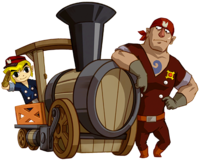
In The Legend of Zelda: Four Swords, Link is split into four Links while wielding the Four Sword, with each Link wearing a differently-colored tunic: green for the original, and red, blue and purple for his copies. The four Links must cooperate, since working together proves to be essential in solving puzzles and defeating Vaati.
This concept would be revisited in The Legend of Zelda: Four Swords Adventures, which sees a different Link in an entirely different timeline split into four in order to defeat a reincarnated Ganon. The Legend of Zelda: The Minish Cap also acts as a predecessor to the Four Swords games, with an earlier incarnation of Link forging the Four Sword. Unlike in the Four Swords games, the Four Sword enables Link to create ghostly copies of himself that also wear green tunics.
A hundred years after Phantom Hourglass, the events for The Legend of Zelda: Spirit Tracks unfold and follow a new Link and a new Princess Zelda, the latter of whom is Tetra's descendant. Unlike Tetra, the Hero of Winds does not make any kind of appearance whatsoever in Spirit Tracks. However, the Hero of Winds' legacy clearly lives on in New Hyrule: his signature clothing is the basis for the uniform worn by the country's soldiers, while the exact same shield that he wielded during Phantom Hourglass can be acquired from Niko, one of his and Tetra's shipmates. As a Royal Engineer, this incarnation of Link dons the Engineer's Clothes and drives the Spirit Train across New Hyrule, teaming up with his mentor Alfonzo and the Phantom-possessing spirit of Zelda in order to stop Malladus from returning to power.
As a spiritual successor to the Four Swords games, The Legend of Zelda: Tri Force Heroes features three Links (with the main hero being the one with a green tunic) teaming up with one another to save Princess Styla of Hytopia. While Link's design in this game closely resembles that of the Hero of the Winds, he is canonically the same incarnation from A Link Between Worlds despite the different art style. In addition to wearing many outfits fashioned by Madame Couture to grant them special abilities, the three Links can stack on top of each other to form Totem Link.
In Super Smash Bros. Brawl
As a playable character
Toon Link is an unlockable character in Super Smash Bros. Brawl, in which he can be unlocked by either clearing Adventure Mode: The Subspace Emissary and/or going through the hidden door in The Forest stage, clearing Classic Mode with any character on any difficulty after clearing The Subspace Emissary, or by participating in 400 VS matches.
As a semi-clone of Link and successor to Young Link, Toon Link's moveset is almost identical to theirs, although with some differences. One of the most obvious is his Bomb, which emits an explosion that uses the art style from The Wind Waker and Phantom Hourglass.
However, there are mechanical differences as well, as the explosion has greater range, but less power compared to Young Link and Link's. Toon Link's neutral special, Hero's Bow, charges faster than Young Link's and shoots arrows farther compared to his and Link's. However, it charges slower than Link's, and his arrows fly slower than Link's. Toon Link's Spin Attack functions like Young Link's, as it traps opponents by hitting them multiple times before launching them away. However, it grants more distance when used as a recovery move, especially in comparison to Link's. Like Young Link, Toon Link possesses the Boomerang as his side special and as such, it provides noticeable differences compared to Link's Gale Boomerang: it does not push/pull opponents and grants more control when throwing it.
In regard to mobility, Toon Link's only differences from Young Link are his higher double jump and lower traction. However, Toon Link's mobility differs considerably from Link's: he walks and dashes faster than Link, his jump is higher and both it and his falling speed are floatier than Link's, and he can wall jump like Young Link. Toon Link's overall power is also similar to Young Link's, yet noticeably lower than Link's. Much like his special moves, a number of Toon Link's standard moves differ from theirs. The most noticeable examples include his up smash, neutral, forward, back and down aerials, and forward and back throws.
Toon Link is currently ranked 13th on the tier list, placing him in the C+ tier. This makes him both the highest ranking incarnation of Link in the Super Smash Bros. series, and the highest ranking fighter from The Legend of Zelda series in Brawl.
Trophies
Toon Link has a trophy that is awarded each time Classic Mode is completed with Toon Link on any difficulty. See Triforce Slash for the trophy description of Toon Link's Final Smash.
- Toon Link
- Link as he appeared in The Wind Waker and Phantom Hourglass, with big eyes and an expressive face. He lived peacefully on Outset Island until a bird captured his little sister, and he came to her rescue. In The Wind Waker, he had to crawl, press up to walls, and the like. His green clothes were worn on his 12th birthday and are the lucky outfit of the hero of legend.
: The Legend of Zelda: The Wind Waker
: The Legend of Zelda: Phantom Hourglass
- Outset Link
- Link in his traditional clothing. He wears a blue, V-neck, long-sleeved top with a shrimp pattern, coordinated with slender orange pants. It makes you think that, even on his home, Outset Island, Link was quite the fashion leader, and suggests that he may have changed into his green hero's clothing somewhat grudgingly.
: The Legend of Zelda: The Wind Waker
Stickers
| Name | Game | Effect | Character(s) |
|---|---|---|---|
| King of Red Lions & Link | The Legend of Zelda: The Wind Waker | ||
| Link & Pigs | The Legend of Zelda: The Wind Waker | ||
| Link | The Legend of Zelda: The Wind Waker |
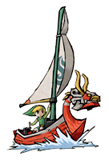 King of Red Lions & Link (Zelda: WW) |
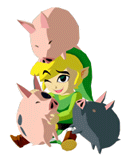 Link & Pigs (Zelda: Wind Waker) |
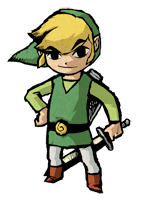 Link (Zelda: Wind Waker) |
In Super Smash Bros. 4
As a playable character
Toon Link returns as a playable character in Super Smash Bros. 4, now as a starter character. Although fairly minor, Toon Link's design nevertheless underwent changes: his overall design and overall color scheme are sleeker and brighter, respectively, which make him virtually identical to his appearance as of The Legend of Zelda: The Wind Waker HD.
Toon Link is currently ranked 23rd on the tier list. While his overall power was nerfed in the transition from Brawl, he retains his powerful zoning potential and gained fairly noticeable improvements to his grab game, the latter of which was arguably his greatest flaw in Brawl. His improved grab game allows for better spacing using his grab aerial, and grants him a KO option in the form of his back throw. Like in Brawl, Toon Link has achieved decent tournament representation and impressive results.
As a background character
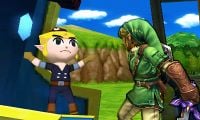
The Spirit Tracks incarnation of Link, also known simply as Engineer Link, appears on Spirit Train as its conductor. However, if Toon Link and/or Link fights on the stage, Alfonzo will be the conductor instead. Engineer Link also has two trophies: one featuring him wearing his Engineer's Clothes, and one featuring him wearing the Recruit Uniform and playing the Spirit Flute.
Trophies
- Toon Link
This cartoonish version of Link is how he appeared in The Legend of Zelda: Wind Waker and a few other titles. In Smash Bros., he uses moves much like his older, taller counterpart. His small size gives him extra speed, though, so take advantage of that to send your foes flying.
This cartoonish version of young Link is how he appears in The Legend of Zelda: The Wind Waker and a few other titles. While he shares some moves with his older counterpart, he's a very different fighter. Take advantage of his size and speed to whirl past enemies and bombard them with long-range attacks.
: The Legend of Zelda: The Wind Waker (03/2003)
: The Legend of Zelda: Spirit Tracks (12/2009)
- Toon Link (Alt.)
Toon Link's Bomb move doesn't deal much damage, but the blast radius is pretty big. His bombs can be thrown in all directions, damaging or distracting your foes. Also, his up special Spin Attack keeps him airborne longer than Link's version. For some launching power, use the side smash attack.
Toon Link's bombs don't do much damage, but their large blast radius makes it easy to hit foes with them. You can also throw them in any directions, making them a great diversionary tactic. His Spin Attack gives him more air-time than Link. His side smash may seem weak, but press the button again for a second hit that'll really send 'em flying!
: The Legend of Zelda: The Wind Waker (03/2003)
: The Legend of Zelda: Spirit Tracks (12/2009)
- Engineer Link
Link is well known for his green clothing, a look he has sported throughout time. But in Spirit Tracks, he dons a blue uniform with a red cap instead. The cap is decorated with a dove, the symbol of the Royal Engineers. Playing the Song of Birds will call a dove to roost!
Ask 100 people what colour Link's outfit is, and they'll all say "green", guaranteed. However, in The Legend of Zelda: Spirit Tracks, he also sports a dark-blue engineer's uniform. Train-driving and world-saving are two skills that should be on every hero's CV!
- Link (Spirit Tracks)
You might feel sorry for this version of Link, what with him living a life on fixed rails rather than exploring the seas or the skies. But, like the smoke from his train, that feeling will soon disappear when you see that after leaving Aboda Village, the young engineer's quest to restore the Spirit Tracks is filled with adventure.
You might feel sorry for this version of Link, what with him living a life on fixed rails rather than exploring the seas or the skies. But, like the smoke from his train, that feeling will soon disappear when you see that, after leaving Outset Village, the young engineer's quest to restore the Spirit Tracks is filled with adventure.
In Super Smash Bros. Ultimate
As a playable character
Toon Link returns as an unlockable character in Super Smash Bros. Ultimate. Unlike in previous games, he is now joined by Young Link, with both characters functioning as derivatives of each other in certain aspects.
As a background character
Engineer Link once again appears on Spirit Train when there are no Links in battle. Compared to SSB4, he appears virtually identical to Toon Link (save for his Engineer's Clothes), instead of using a polygonal model similar to the ones in Phantom Hourglass and Spirit Tracks.
Spirits
Fighter spirit
Primary spirits
Support spirit
| No. | Image | Name | Class | Cost | Ability | Series |
|---|---|---|---|---|---|---|
| 260 | Alfonzo & Engineer Link | ★★ | 1 | Dash Attack ↑ | The Legend of Zelda Series |
Names in other languages
Trivia
- Toon Link's artwork in Super Smash Bros. Brawl closely resembles his artwork in The Wind Waker. The only differences are the former's mirrored hairstyle, slight re-positioning of his arms, and a lack of the apparent gust of wind.
- Prior to Super Smash Bros. Ultimate, Toon Link, Young Link and Roy were the only swordsmen in the Super Smash Bros. series whose swords consistently produced a punch/kick sound effect, instead of a slashing sound effect, for the majority of their moves.
- Toon Link, Young Link and Cloud Strife are the only swordsmen in the Super Smash Bros. series capable of wall jumping.
- Despite being able to crawl in their respective games, Toon Link, Mario, Donkey Kong, Young Link, and Pit are unable to do so in the Super Smash Bros. series.
- Toon Link is the only playable character from The Legend of Zelda series:
- To have debuted in the 21st century.
- Whose design remains the same for more than two Super Smash Bros. games in a row. This is very similar to how his "Toon" design has been used for more games in his home series than any of the realistically designed Links.
- Despite being associated with the Adult Timeline, the "Toon" design has also been used in every other established timeline: the Unified Timeline (Four Swords and The Minish Cap), the Child Timeline (Four Swords Adventures), and the Downfall Timeline (Tri Force Heroes). Interestingly enough, Skyward Sword and Breath of the Wild used cel-shading like the "Toon" games, but instead featured anatomically realistic character designs. Additionally, despite using the "Toon" artstyle, the Link seen in Tri Force Heroes is actually in fact implied to be the same Link from The Legend of Zelda: A Link Between Worlds.
- Hyrule Warriors is the only other game outside of the Super Smash Bros. series where the Hero of Winds is referred to as "Toon Link" instead of simply Link.
- On a related note, Hyrule Warriors is also the first game to refer to use the "Toon" term in reference to the art style itself, as shown by it referral of the Princess Zelda from The Legend of Zelda: Spirit Tracks as "Toon Zelda".
- The Super Smash Bros. series depicts Toon Link wielding both the Master Sword and Hero's Shield in all of his playable appearances, with the former being based on its appearance when its power to repel evil is fully restored. This is inaccurate to his appearance in The Wind Waker, as the Mirror Shield would replace the Hero's Shield by the time the fully powered Master Sword is obtained.
Notes
- 1.^ Although 2D artwork of the "Toon" art style debuted alongside The Legend of Zelda: Four Swords, which was released shortly before The Legend of Zelda: The Wind Waker, the art style itself was technically established during The Wind Waker's development cycle,[1] which occurred before Four Swords' development cycle.[3]
References
